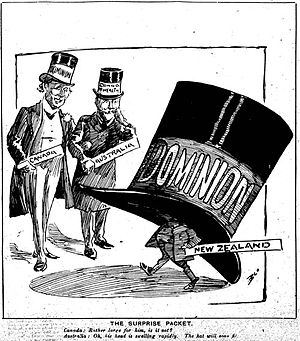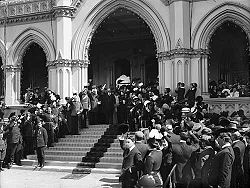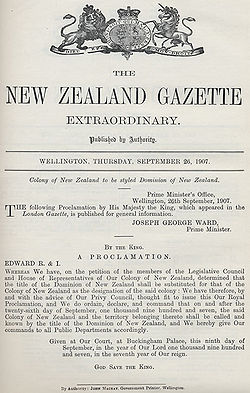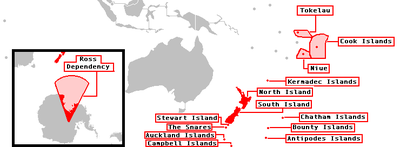- Dominion of New Zealand
-
The Dominion of New Zealand is the former name of the Realm of New Zealand.
Originally administered from New South Wales, New Zealand became a direct British colony in 1841 and received a large measure of self-government following the New Zealand Constitution Act 1852. New Zealand chose not to take part in Australian Federation and assumed complete self-government as the Dominion of New Zealand on 26 September 1907, Dominion Day, by proclamation of King Edward VII.
Contents
Dominion
Following the 1907 Imperial Conference, the New Zealand House of Representatives passed a motion respectfully requesting that His Majesty the King "take such steps as he may consider necessary" to change the designation of New Zealand from the "Colony of New Zealand" to the "Dominion of New Zealand".
Debate
The alteration in status was stirred by a sentiment on the part of the Prime Minister of the self-governing colonies of the British Empire that a new term was necessary to differentiate them from the non-self-governing colonies, such as (at that time) Fiji.
The adoption of the designation of Dominion would, "raise the status of New Zealand" stated Prime Minister Joseph Ward and "...have no other effect than that of doing the country good".[1] The change was opposed by Leader of the Opposition Bill Massey.
Royal Proclamation
A Royal Proclamation granting New Zealand Dominion status was issued on 9 September 1907.
- It read - "EDWARD R.& I. Whereas We have on the Petition of the Members of the Legislative Council and House of Representatives of Our Colony of New Zealand determined that the title of Dominion of New Zealand shall be substituted for that of the Colony of New Zealand as the designation of the said Colony, We have therefore by and with the advice of Our Privy Council thought fit to issue this Our Royal Proclamation and We do ordain, declare and command that on and after the twenty-sixth day of September, one thousand nine hundred and seven, the said Colony of New Zealand and the territory belonging thereto shall be called and known by the title of the Dominion of New Zealand. And We hereby give Our Commands to all Public Departments accordingly. Given at Our Court at Buckingham Palace, this ninth day of September, in the year of Our Lord one thousand nine hundred and seven, and in the seventh year of Our Reign. GOD save the KING."
Effect
 The New Zealand Observer (1907) shows Prime Minister Joseph Ward as a pretentious dwarf beneath a massive ‘dominion’ top hat. The caption reads: The Surprise Packet:
The New Zealand Observer (1907) shows Prime Minister Joseph Ward as a pretentious dwarf beneath a massive ‘dominion’ top hat. The caption reads: The Surprise Packet:
Canada: "Rather large for him, is it not?"
Australia: "Oh his head is swelling rapidly. The hat will soon fit."Dominion status allowed the dominions to become virtually independent, while retaining the British monarch as head of state, represented locally by a governor-general appointed in consultation with the Dominion’s government. Control over defence, constitutional amendments and (partially) foreign affairs, remained with the British government, until the Statute of Westminster was adopted.
In 1907 new Letters Patent were issued to mark New Zealand’s change in status from Crown Colony to Dominion declaring that: “there shall be a Governor and Commander-in-Chief in and over Our Dominion of New Zealand”.
In 1917 Letters Patent were issued again re-designating the title Governor to Governor-General of New Zealand. The changes in the Governor-General’s title were intended to reflect more fully New Zealand’s self-governing status. The 1917 Letters Patent constituted the office “Governor-General and Commander-in-Chief in and over Our Dominion of New Zealand”.
Until 1911 New Zealand used the Coat of Arms of the United Kingdom on all official documents and public buildings, however following Dominion status a new Coat of Arms of New Zealand was designed.
Despite this new status, there was some apprehension in 1919 when Prime Minister Bill Massey signed the Treaty of Versailles (giving New Zealand membership of the League of Nations), which indicated that New Zealand did have a degree of control over its foreign affairs. Massey was unequivocally an Imperialist, and fervently supported the British Empire.
In 1926 the imperial conference devised the Balfour formula of dominion status, stating that the United Kingdom and the Dominions:
“ are autonomous Communities within the British Empire, equal in status, in no way subordinate one to another in any aspect of their domestic or external affairs, though united by a common allegiance to the Crown, and freely associated as members of the British Commonwealth ” —Balfour Declaration 1926[2]
The Balfour Report further resolved that Governors-General occupied “the same position in relation to the administration of public affairs in the Dominion” as was held by the Monarch in the United Kingdom. The only advisers to the Governor-General and the Monarch in New Zealand were his New Zealand Ministers.
Prime Minister Gordon Coates, who led the New Zealand delegation to the 1926 Conference, called the Balfour Declaration a 'poisonous document' that would weaken the ties of empire.
At the 1930 Imperial Conference, the conclusions of the conference were re-stated, and Sir Thomas Sidey obtained a clause exempting New Zealand from the Statute of Westminster until such time as it should be ratified by the New Zealand Parliament.
Dominion Day
To mark the granting of Dominion status, 26 September was declared Dominion Day. Today, it is observed only as a Provincial Anniversary Day holiday in South Canterbury. There is support in some quarters for the day to be revived as an alternative New Zealand Day, instead of renaming Waitangi Day, New Zealand's current national day. The Wellington newspaper The Dominion (now The Dominion Post) was first published on this day in 1907.
Statute of Westminster
In 1931, the British Parliament passed the Statute of Westminster, which confirmed complete autonomy for its dominions, and gave effect to resolutions passed by the imperial conferences of 1926 and 1930.
Preferring the United Kingdom to handle most of its foreign affairs and defence, New Zealand held back from adopting the Statute of Westminster Act, and, 16 years later, was the last dominion listed in the Statute to do so. The National opposition prompted the adoption of the Statute in 1947 when its leader, and future Prime Minister Sidney Holland introduced a private members' bill to abolish the New Zealand Legislative Council. Because New Zealand required the consent of the Parliament of the United Kingdom to amend the New Zealand Constitution Act 1852, Prime Minister Peter Fraser decided to finally adopt the Statute.[3] The Statute was adopted on 25 November 1947 with the Statute of Westminster Adoption Act 1947, along with consenting legislation from the British Parliament, meaning the British parliament could no longer make ordinary law for the dominion, other than at New Zealand's request and consent.
Dominion gives way to "Realm"
In 1946 Prime Minister Peter Fraser instructed Government departments not to use the term 'Dominion' any longer. It was not until 1953, however, that the term 'Dominion' began to be replaced.[4] There is a view that dominion status was replaced by realm status in the Queen's Accession Proclamation of 11 February 1952:
“ The High and Mighty Princess Elizabeth Alexandra Mary is now, by the death of our late Sovereign of happy memory, become Queen Elizabeth the Second, by the grace of God, Queen of this realm and of all her other realms and territories, Head of the Commonwealth, Defender of the Faith ... ” —Accession Proclamation (1952) I New Zealand Gazette 1952
In 1953 Her Majesty proclaimed a separate Royal Title for use in New Zealand
“ Elizabeth the Second, by the Grace of God of the United Kingdom, New Zealand and Her Other Realms and Territories Queen, Head of the Commonwealth, Defender of the Faith. ” — Royal Titles Act 1953 (NZ), s 2; Royal Titles Proclamation (1953) II New Zealand Gazette 851
.
However there was no proclamation that the official status of New Zealand had been changed from Dominion of New Zealand. Furthermore the proclamation of 1907 was not revoked or amended. The term Dominion gradually fell into disuse after 1953, and has been rarely used since the 1970s. Since then the term "Realm" has been increasingly used for New Zealand.
Today the Realm of New Zealand comprises New Zealand, Tokelau and the Ross Dependency, and the self-governing states of the Cook Islands and Niue. Former Dominions of the British Empire that have the British Monarch as their Head of State (including Canada and Australia) are known as Commonwealth Realms.
Thus New Zealand is now an independent kingdom where the sovereign reigns no longer as the British Monarch, but as the Monarch of New Zealand.
See also
References
- ^ Report on the Inquiry into New Zealand’s Constitutional Arrangements
- ^ "Balfour Declaration 1926 (Imperial Conference)". National Archives of Australia. http://www.foundingdocs.gov.au/item.asp?dID=24. Retrieved 2006-07-23.
- ^ Michael Bassett and Michael King (2001). "Tomorrow Comes the Song: A Life of Peter Fraser". Penguin Books. http://www.michaelbassett.co.nz/book_tomorrow.htm. Retrieved 2007-10-26.
- ^ Dame Silvia Cartwright (2001). "The Role of the Governor-General". Governor-General of New Zealand. Archived from the original on 2006-10-16. http://web.archive.org/web/20061016173822/http://gg.govt.nz/media/speeches.asp?type=constitutional&ID=229. Retrieved 2006-07-23.
Further reading
- McIntyre, David (1999). "The Strange Death of Dominion Status". Journal of Imperial and Commonwealth History: 193, 196.
British Empire and Commonwealth of Nations Legend
Current territory · Former territory
* now a Commonwealth realm · now a member of the Commonwealth of NationsEurope18th century
1708–1757 Minorca
since 1713 Gibraltar
1763–1782 Minorca
1798–1802 Minorca19th century
1800–1964 Malta
1807–1890 Heligoland
1809–1864 Ionian Islands20th century
1921-1937 Irish Free StateNorth America17th century
1583–1907 Newfoundland
1607–1776 Virginia
since 1619 Bermuda
1620–1691 Plymouth Colony
1629–1691 Massachusetts Bay Colony
1632–1776 Maryland
1636–1776 Connecticut
1636–1776 Rhode Island
1637–1662 New Haven Colony
1663–1712 Carolina
1664–1776 New York
1665–1674 and 1702-1776 New Jersey
1670–1870 Rupert's Land
1674–1702 East Jersey
1674–1702 West Jersey
1680–1776 New Hampshire
1681–1776 Pennsylvania
1686–1689 Dominion of New England
1691–1776 Massachusetts18th century
1701–1776 Delaware
1712–1776 North Carolina
1712–1776 South Carolina
1713–1867 Nova Scotia
1733–1776 Georgia
1763–1873 Prince Edward Island
1763–1791 Quebec
1763–1783 East Florida
1763–1783 West Florida
1784–1867 New Brunswick
1791–1841 Lower Canada
1791–1841 Upper Canada19th century
1818–1846 Columbia District / Oregon Country1
1841–1867 Province of Canada
1849–1866 Vancouver Island
1853–1863 Colony of the Queen Charlotte Islands
1858–1866 British Columbia
1859–1870 North-Western Territory
1862–1863 Stikine Territory
1866–1871 Vancouver Island and British Columbia
1867–1931 *Dominion of Canada2
20th century
1907–1949 Dominion of Newfoundland31Occupied jointly with the United States
2In 1931, Canada and other British dominions obtained self-government through the Statute of Westminster. see Canada's name.
3Gave up self-rule in 1934, but remained a de jure Dominion until it joined Canada in 1949.Latin America and the Caribbean17th century
1605–1979 *Saint Lucia
1623–1883 Saint Kitts (*Saint Kitts & Nevis)
1624–1966 *Barbados
1625–1650 Saint Croix
1627–1979 *St. Vincent and the Grenadines
1628–1883 Nevis (*Saint Kitts & Nevis)
1629–1641 St. Andrew and Providence Islands4
since 1632 Montserrat
1632–1860 Antigua (*Antigua & Barbuda)
1643–1860 Bay Islands
since 1650 Anguilla
1651–1667 Willoughbyland (Suriname)
1655–1850 Mosquito Coast (protectorate)
1655–1962 *Jamaica
since 1666 British Virgin Islands
since 1670 Cayman Islands
1670–1973 *Bahamas
1670–1688 St. Andrew and Providence Islands4
1671–1816 Leeward Islands
18th century
1762–1974 *Grenada
1763–1978 Dominica
since 1799 Turks and Caicos Islands19th century
1831–1966 British Guiana (Guyana)
1833–1960 Windward Islands
1833–1960 Leeward Islands
1860–1981 *Antigua and Barbuda
1871–1964 British Honduras (*Belize)
1882–1983 *Saint Kitts.2C 1623 to 1700|St. Kitts and Nevis
1889–1962 Trinidad and Tobago
20th century
1958–1962 West Indies Federation4Now the San Andrés y Providencia Department of Colombia
AfricaAsiaOceania18th century
1788–1901 New South Wales19th century
1803–1901 Van Diemen's Land/Tasmania
1807–1863 Auckland Islands7
1824–1980 New Hebrides (Vanuatu)
1824–1901 Queensland
1829–1901 Swan River Colony/Western Australia
1836–1901 South Australia
since 1838 Pitcairn Islands
1841–1907 Colony of New Zealand
1851–1901 Victoria
1874–1970 Fiji8
1877–1976 British Western Pacific Territories
1884–1949 Territory of Papua
1888–1965 Cook Islands7
1889–1948 Union Islands (Tokelau)7
1892–1979 Gilbert and Ellice Islands9
1893–1978 British Solomon Islands1020th century
1900–1970 Tonga (protected state)
1900–1974 Niue7
1901–1942 *Commonwealth of Australia
1907–1953 *Dominion of New Zealand
1919–1942 Nauru
1945–1968 Nauru
1919–1949 Territory of New Guinea
1949–1975 Territory of Papua and New Guinea117Now part of the *Realm of New Zealand
8Suspended member
9Now Kiribati and *Tuvalu
10Now the *Solomon Islands
11Now *Papua New GuineaAntarctica and South Atlantic17th century
since 1659 St. Helena1219th century
since 1815 Ascension Island12
since 1816 Tristan da Cunha12
since 1833 Falkland Islands1320th century
since 1908 British Antarctic Territory14
since 1908 South Georgia and the South Sandwich Islands13, 1412Since 2009 part of Saint Helena, Ascension and Tristan da Cunha; Ascension Island (1922—) and Tristan da Cunha (1938—) were previously dependencies of St Helena
13Occupied by Argentina during the Falklands War of April–June 1982
14Both claimed in 1908; territories formed in 1962 (British Antarctic Territory) and 1985 (South Georgia and the South Sandwich Islands)Categories:- Political history of New Zealand
- European colonisation in Oceania
Wikimedia Foundation. 2010.



